Clinical Trial Statistical Analysis: Hyaluronic Acid vs Corticosteroid
VerifiedAdded on 2023/06/15
|14
|2824
|304
Literature Review
AI Summary
This document presents a statistical analysis of a clinical trial investigating non-operative treatments for joint osteoarthritis, specifically comparing intra-articular injections of hyaluronic acid and corticosteroids. The analysis includes a review of the study's purpose, research design, sampling methods, and methodology. It evaluates the study's validity, treatment effects, and statistical methods, with a focus on determining the safety and efficacy of hyaluronic acid compared to corticosteroids. The review also addresses study limitations and the clinical significance of the results, referencing relevant research articles and discussing the implications for managing patients with joint osteoarthritis. The ultimate goal of this document is to contribute towards the research of osteoarthritis and its treatment. Desklib provides a platform for students to access similar documents, past papers, and AI-based study tools to support their academic endeavors.
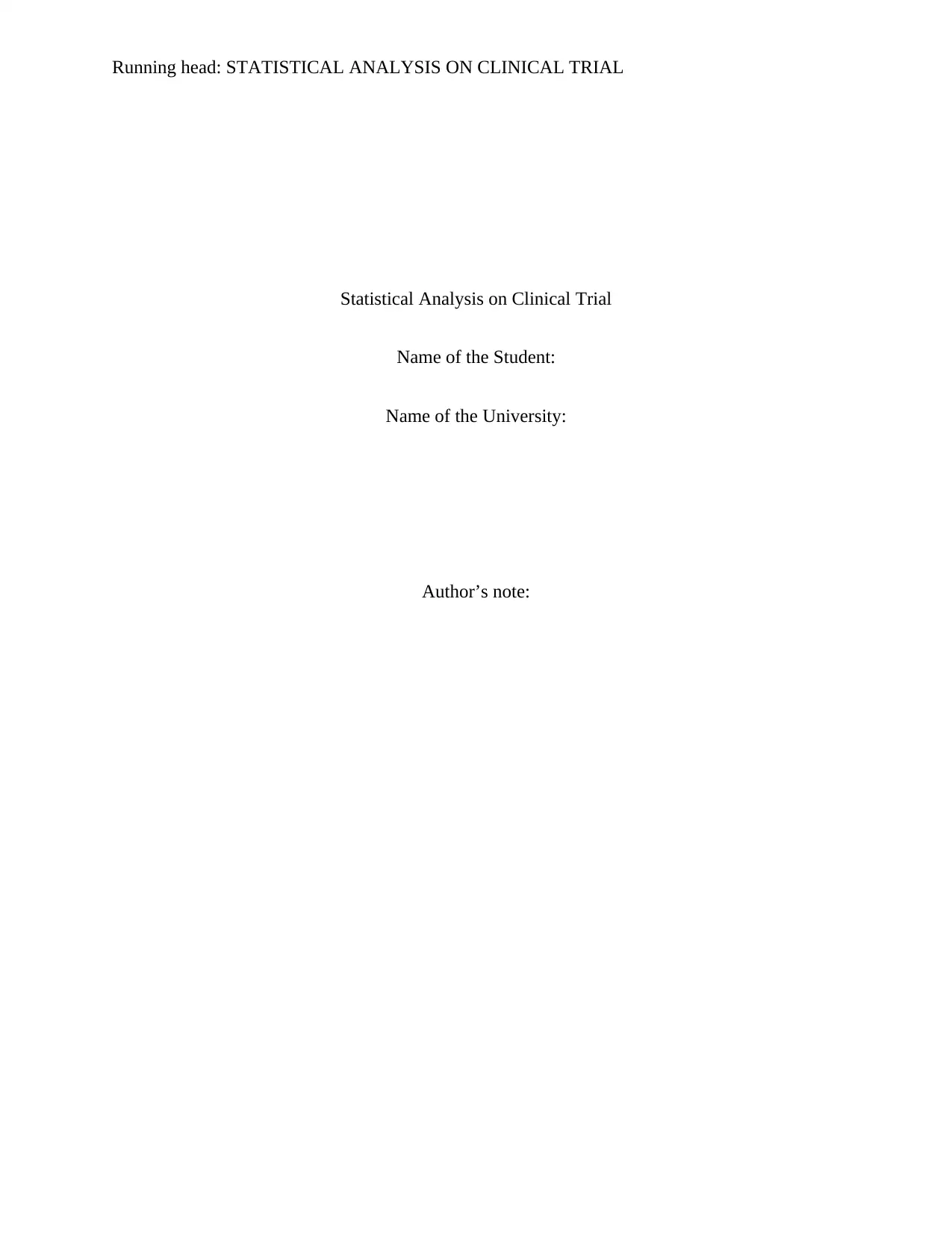
Running head: STATISTICAL ANALYSIS ON CLINICAL TRIAL
Statistical Analysis on Clinical Trial
Name of the Student:
Name of the University:
Author’s note:
Statistical Analysis on Clinical Trial
Name of the Student:
Name of the University:
Author’s note:
Paraphrase This Document
Need a fresh take? Get an instant paraphrase of this document with our AI Paraphraser
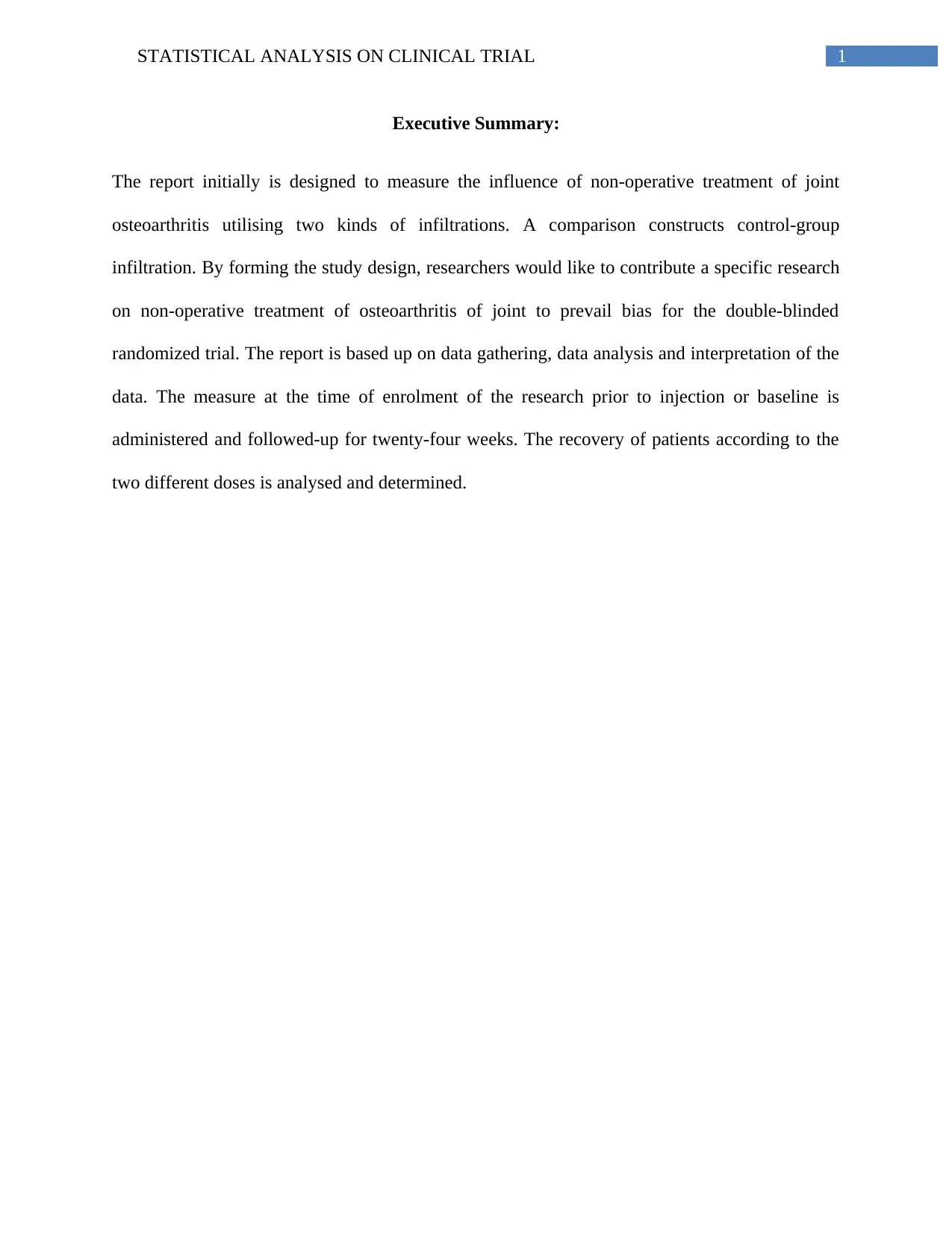
1STATISTICAL ANALYSIS ON CLINICAL TRIAL
Executive Summary:
The report initially is designed to measure the influence of non-operative treatment of joint
osteoarthritis utilising two kinds of infiltrations. A comparison constructs control-group
infiltration. By forming the study design, researchers would like to contribute a specific research
on non-operative treatment of osteoarthritis of joint to prevail bias for the double-blinded
randomized trial. The report is based up on data gathering, data analysis and interpretation of the
data. The measure at the time of enrolment of the research prior to injection or baseline is
administered and followed-up for twenty-four weeks. The recovery of patients according to the
two different doses is analysed and determined.
Executive Summary:
The report initially is designed to measure the influence of non-operative treatment of joint
osteoarthritis utilising two kinds of infiltrations. A comparison constructs control-group
infiltration. By forming the study design, researchers would like to contribute a specific research
on non-operative treatment of osteoarthritis of joint to prevail bias for the double-blinded
randomized trial. The report is based up on data gathering, data analysis and interpretation of the
data. The measure at the time of enrolment of the research prior to injection or baseline is
administered and followed-up for twenty-four weeks. The recovery of patients according to the
two different doses is analysed and determined.

2STATISTICAL ANALYSIS ON CLINICAL TRIAL
Table of Contents
Introduction and Background:.........................................................................................................3
PICO question:.................................................................................................................................3
Journal article:.................................................................................................................................3
Study Purpose:-................................................................................................................................4
Rationale of the Research:-..............................................................................................................4
Description of how it meets the inclusion criteria:-.........................................................................4
Research Question of the study:-.....................................................................................................5
Does the study’s research question (PICO) match your question PICO?.......................................5
Research Design:-............................................................................................................................5
Was the assignment of patients to treatments randomized?........................................................5
Were the groups similar at the start of the trial?..........................................................................6
Aside from the allocated treatment, were the group treated equally?.........................................6
Sampling Methods:-.........................................................................................................................6
Blinding:-.....................................................................................................................................7
Sample Description:-.......................................................................................................................7
Research Methodology:-..................................................................................................................8
Subject Mortality:-...........................................................................................................................8
Study Results:-.................................................................................................................................8
Table of Contents
Introduction and Background:.........................................................................................................3
PICO question:.................................................................................................................................3
Journal article:.................................................................................................................................3
Study Purpose:-................................................................................................................................4
Rationale of the Research:-..............................................................................................................4
Description of how it meets the inclusion criteria:-.........................................................................4
Research Question of the study:-.....................................................................................................5
Does the study’s research question (PICO) match your question PICO?.......................................5
Research Design:-............................................................................................................................5
Was the assignment of patients to treatments randomized?........................................................5
Were the groups similar at the start of the trial?..........................................................................6
Aside from the allocated treatment, were the group treated equally?.........................................6
Sampling Methods:-.........................................................................................................................6
Blinding:-.....................................................................................................................................7
Sample Description:-.......................................................................................................................7
Research Methodology:-..................................................................................................................8
Subject Mortality:-...........................................................................................................................8
Study Results:-.................................................................................................................................8
⊘ This is a preview!⊘
Do you want full access?
Subscribe today to unlock all pages.

Trusted by 1+ million students worldwide
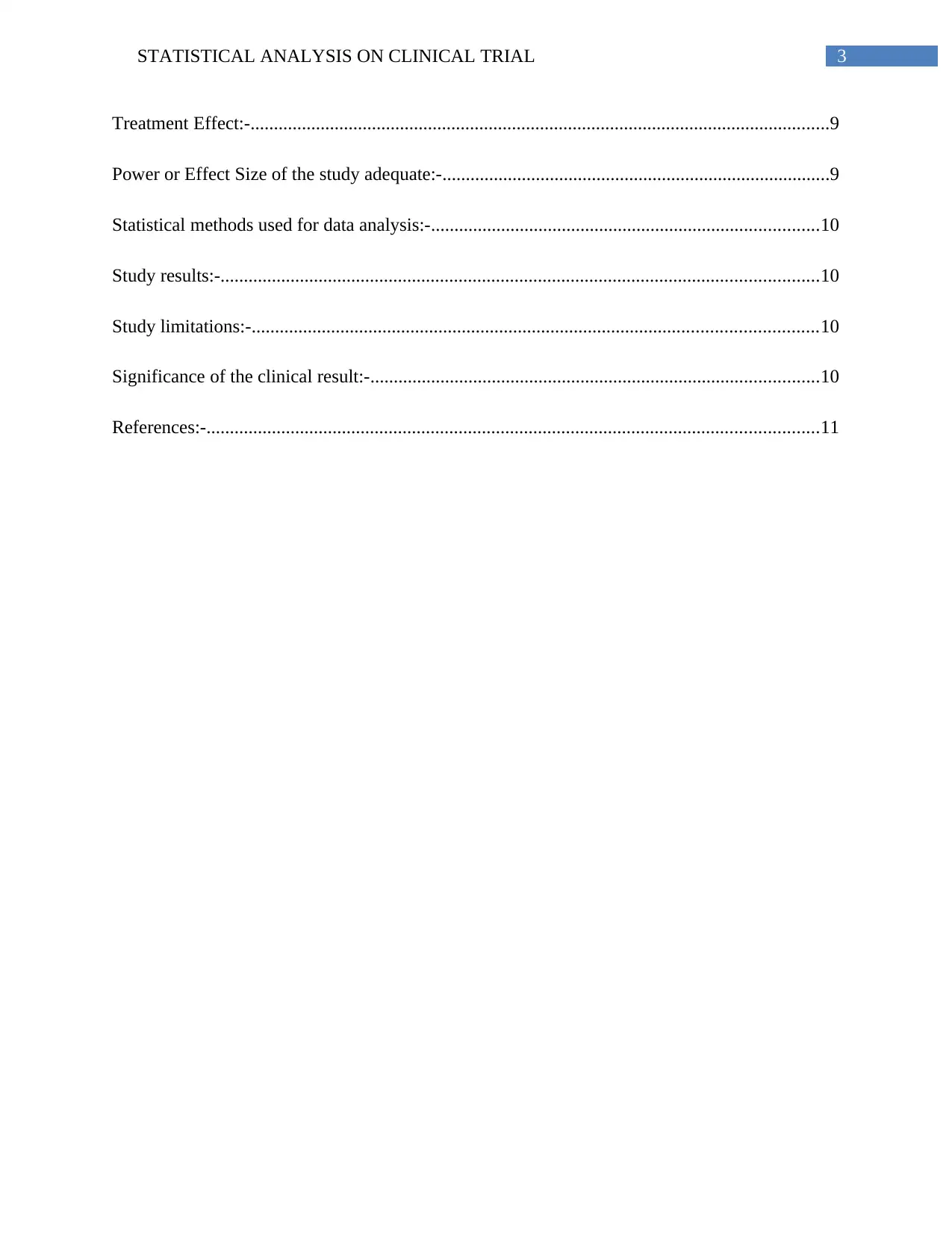
3STATISTICAL ANALYSIS ON CLINICAL TRIAL
Treatment Effect:-............................................................................................................................9
Power or Effect Size of the study adequate:-...................................................................................9
Statistical methods used for data analysis:-...................................................................................10
Study results:-................................................................................................................................10
Study limitations:-.........................................................................................................................10
Significance of the clinical result:-................................................................................................10
References:-...................................................................................................................................11
Treatment Effect:-............................................................................................................................9
Power or Effect Size of the study adequate:-...................................................................................9
Statistical methods used for data analysis:-...................................................................................10
Study results:-................................................................................................................................10
Study limitations:-.........................................................................................................................10
Significance of the clinical result:-................................................................................................10
References:-...................................................................................................................................11
Paraphrase This Document
Need a fresh take? Get an instant paraphrase of this document with our AI Paraphraser
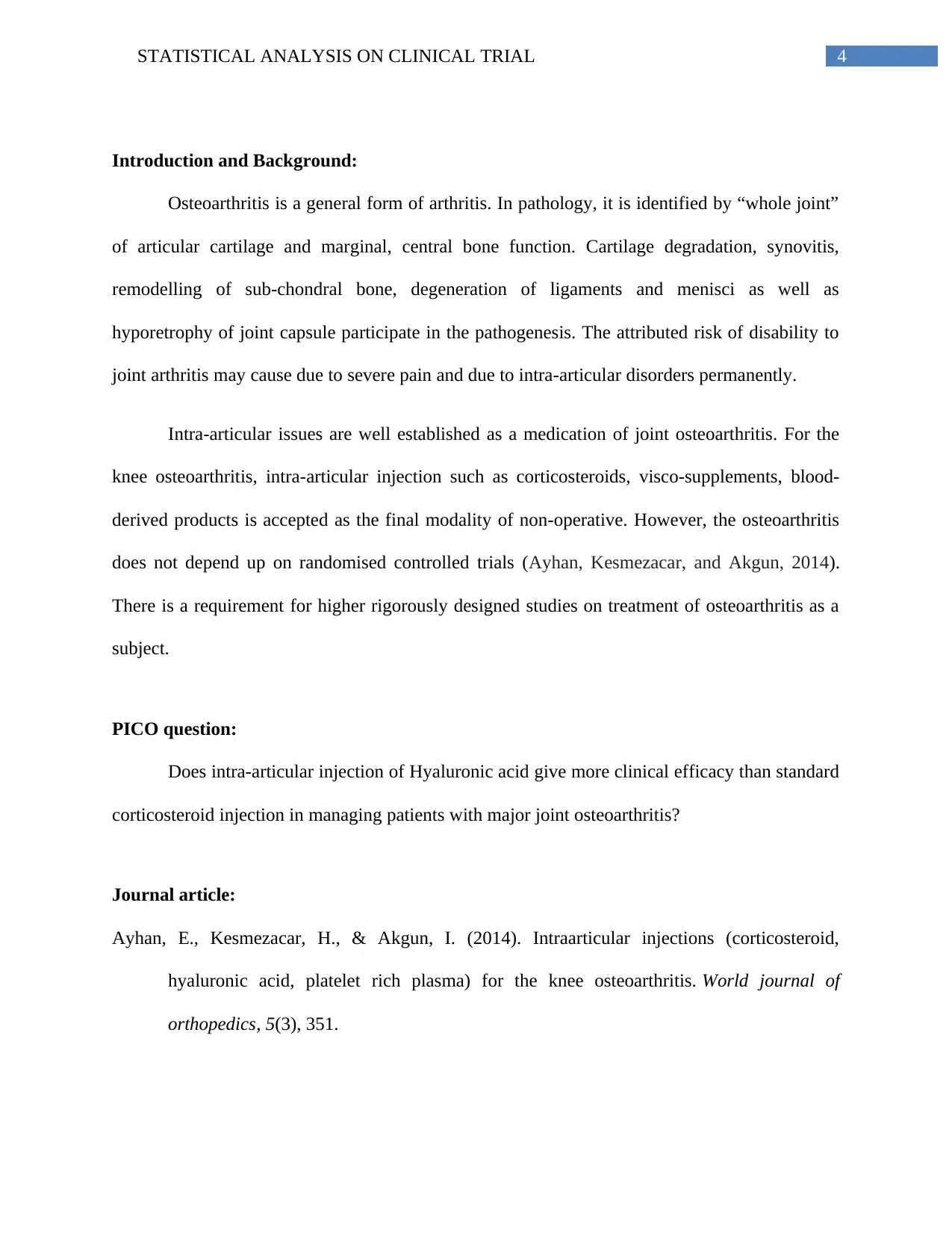
4STATISTICAL ANALYSIS ON CLINICAL TRIAL
Introduction and Background:
Osteoarthritis is a general form of arthritis. In pathology, it is identified by “whole joint”
of articular cartilage and marginal, central bone function. Cartilage degradation, synovitis,
remodelling of sub-chondral bone, degeneration of ligaments and menisci as well as
hyporetrophy of joint capsule participate in the pathogenesis. The attributed risk of disability to
joint arthritis may cause due to severe pain and due to intra-articular disorders permanently.
Intra-articular issues are well established as a medication of joint osteoarthritis. For the
knee osteoarthritis, intra-articular injection such as corticosteroids, visco-supplements, blood-
derived products is accepted as the final modality of non-operative. However, the osteoarthritis
does not depend up on randomised controlled trials (Ayhan, Kesmezacar, and Akgun, 2014).
There is a requirement for higher rigorously designed studies on treatment of osteoarthritis as a
subject.
PICO question:
Does intra-articular injection of Hyaluronic acid give more clinical efficacy than standard
corticosteroid injection in managing patients with major joint osteoarthritis?
Journal article:
Ayhan, E., Kesmezacar, H., & Akgun, I. (2014). Intraarticular injections (corticosteroid,
hyaluronic acid, platelet rich plasma) for the knee osteoarthritis. World journal of
orthopedics, 5(3), 351.
Introduction and Background:
Osteoarthritis is a general form of arthritis. In pathology, it is identified by “whole joint”
of articular cartilage and marginal, central bone function. Cartilage degradation, synovitis,
remodelling of sub-chondral bone, degeneration of ligaments and menisci as well as
hyporetrophy of joint capsule participate in the pathogenesis. The attributed risk of disability to
joint arthritis may cause due to severe pain and due to intra-articular disorders permanently.
Intra-articular issues are well established as a medication of joint osteoarthritis. For the
knee osteoarthritis, intra-articular injection such as corticosteroids, visco-supplements, blood-
derived products is accepted as the final modality of non-operative. However, the osteoarthritis
does not depend up on randomised controlled trials (Ayhan, Kesmezacar, and Akgun, 2014).
There is a requirement for higher rigorously designed studies on treatment of osteoarthritis as a
subject.
PICO question:
Does intra-articular injection of Hyaluronic acid give more clinical efficacy than standard
corticosteroid injection in managing patients with major joint osteoarthritis?
Journal article:
Ayhan, E., Kesmezacar, H., & Akgun, I. (2014). Intraarticular injections (corticosteroid,
hyaluronic acid, platelet rich plasma) for the knee osteoarthritis. World journal of
orthopedics, 5(3), 351.
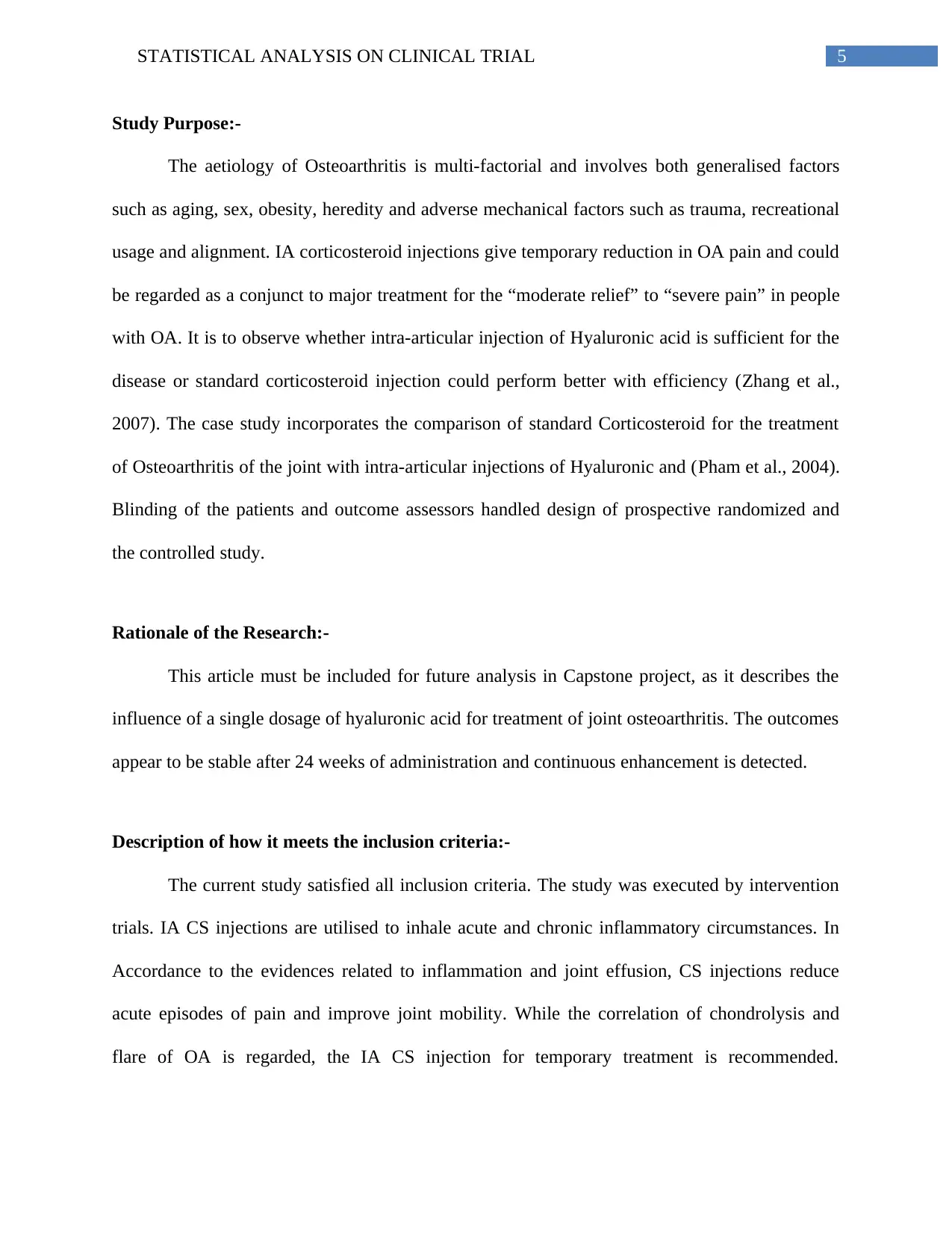
5STATISTICAL ANALYSIS ON CLINICAL TRIAL
Study Purpose:-
The aetiology of Osteoarthritis is multi-factorial and involves both generalised factors
such as aging, sex, obesity, heredity and adverse mechanical factors such as trauma, recreational
usage and alignment. IA corticosteroid injections give temporary reduction in OA pain and could
be regarded as a conjunct to major treatment for the “moderate relief” to “severe pain” in people
with OA. It is to observe whether intra-articular injection of Hyaluronic acid is sufficient for the
disease or standard corticosteroid injection could perform better with efficiency (Zhang et al.,
2007). The case study incorporates the comparison of standard Corticosteroid for the treatment
of Osteoarthritis of the joint with intra-articular injections of Hyaluronic and (Pham et al., 2004).
Blinding of the patients and outcome assessors handled design of prospective randomized and
the controlled study.
Rationale of the Research:-
This article must be included for future analysis in Capstone project, as it describes the
influence of a single dosage of hyaluronic acid for treatment of joint osteoarthritis. The outcomes
appear to be stable after 24 weeks of administration and continuous enhancement is detected.
Description of how it meets the inclusion criteria:-
The current study satisfied all inclusion criteria. The study was executed by intervention
trials. IA CS injections are utilised to inhale acute and chronic inflammatory circumstances. In
Accordance to the evidences related to inflammation and joint effusion, CS injections reduce
acute episodes of pain and improve joint mobility. While the correlation of chondrolysis and
flare of OA is regarded, the IA CS injection for temporary treatment is recommended.
Study Purpose:-
The aetiology of Osteoarthritis is multi-factorial and involves both generalised factors
such as aging, sex, obesity, heredity and adverse mechanical factors such as trauma, recreational
usage and alignment. IA corticosteroid injections give temporary reduction in OA pain and could
be regarded as a conjunct to major treatment for the “moderate relief” to “severe pain” in people
with OA. It is to observe whether intra-articular injection of Hyaluronic acid is sufficient for the
disease or standard corticosteroid injection could perform better with efficiency (Zhang et al.,
2007). The case study incorporates the comparison of standard Corticosteroid for the treatment
of Osteoarthritis of the joint with intra-articular injections of Hyaluronic and (Pham et al., 2004).
Blinding of the patients and outcome assessors handled design of prospective randomized and
the controlled study.
Rationale of the Research:-
This article must be included for future analysis in Capstone project, as it describes the
influence of a single dosage of hyaluronic acid for treatment of joint osteoarthritis. The outcomes
appear to be stable after 24 weeks of administration and continuous enhancement is detected.
Description of how it meets the inclusion criteria:-
The current study satisfied all inclusion criteria. The study was executed by intervention
trials. IA CS injections are utilised to inhale acute and chronic inflammatory circumstances. In
Accordance to the evidences related to inflammation and joint effusion, CS injections reduce
acute episodes of pain and improve joint mobility. While the correlation of chondrolysis and
flare of OA is regarded, the IA CS injection for temporary treatment is recommended.
⊘ This is a preview!⊘
Do you want full access?
Subscribe today to unlock all pages.

Trusted by 1+ million students worldwide
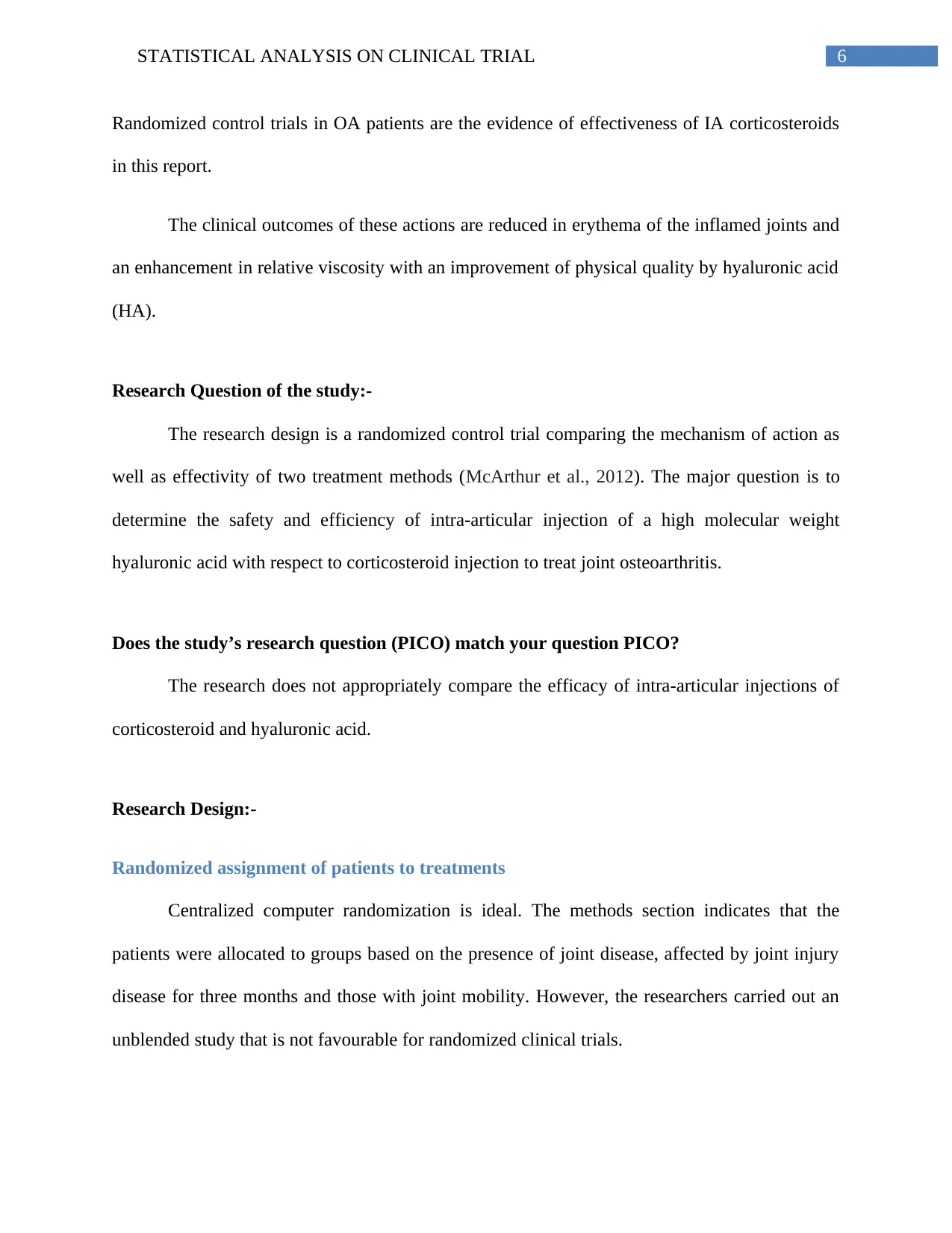
6STATISTICAL ANALYSIS ON CLINICAL TRIAL
Randomized control trials in OA patients are the evidence of effectiveness of IA corticosteroids
in this report.
The clinical outcomes of these actions are reduced in erythema of the inflamed joints and
an enhancement in relative viscosity with an improvement of physical quality by hyaluronic acid
(HA).
Research Question of the study:-
The research design is a randomized control trial comparing the mechanism of action as
well as effectivity of two treatment methods (McArthur et al., 2012). The major question is to
determine the safety and efficiency of intra-articular injection of a high molecular weight
hyaluronic acid with respect to corticosteroid injection to treat joint osteoarthritis.
Does the study’s research question (PICO) match your question PICO?
The research does not appropriately compare the efficacy of intra-articular injections of
corticosteroid and hyaluronic acid.
Research Design:-
Randomized assignment of patients to treatments
Centralized computer randomization is ideal. The methods section indicates that the
patients were allocated to groups based on the presence of joint disease, affected by joint injury
disease for three months and those with joint mobility. However, the researchers carried out an
unblended study that is not favourable for randomized clinical trials.
Randomized control trials in OA patients are the evidence of effectiveness of IA corticosteroids
in this report.
The clinical outcomes of these actions are reduced in erythema of the inflamed joints and
an enhancement in relative viscosity with an improvement of physical quality by hyaluronic acid
(HA).
Research Question of the study:-
The research design is a randomized control trial comparing the mechanism of action as
well as effectivity of two treatment methods (McArthur et al., 2012). The major question is to
determine the safety and efficiency of intra-articular injection of a high molecular weight
hyaluronic acid with respect to corticosteroid injection to treat joint osteoarthritis.
Does the study’s research question (PICO) match your question PICO?
The research does not appropriately compare the efficacy of intra-articular injections of
corticosteroid and hyaluronic acid.
Research Design:-
Randomized assignment of patients to treatments
Centralized computer randomization is ideal. The methods section indicates that the
patients were allocated to groups based on the presence of joint disease, affected by joint injury
disease for three months and those with joint mobility. However, the researchers carried out an
unblended study that is not favourable for randomized clinical trials.
Paraphrase This Document
Need a fresh take? Get an instant paraphrase of this document with our AI Paraphraser
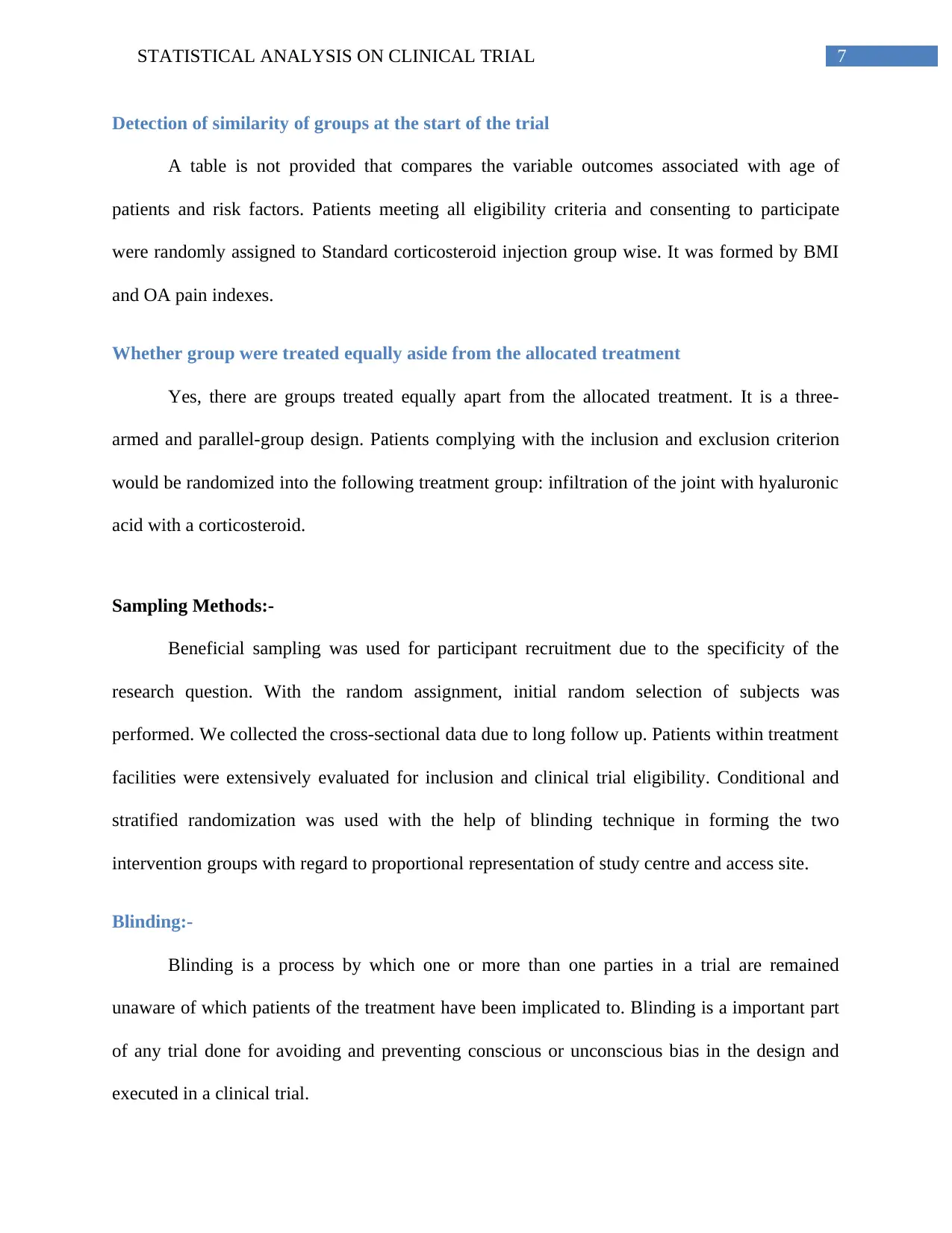
7STATISTICAL ANALYSIS ON CLINICAL TRIAL
Detection of similarity of groups at the start of the trial
A table is not provided that compares the variable outcomes associated with age of
patients and risk factors. Patients meeting all eligibility criteria and consenting to participate
were randomly assigned to Standard corticosteroid injection group wise. It was formed by BMI
and OA pain indexes.
Whether group were treated equally aside from the allocated treatment
Yes, there are groups treated equally apart from the allocated treatment. It is a three-
armed and parallel-group design. Patients complying with the inclusion and exclusion criterion
would be randomized into the following treatment group: infiltration of the joint with hyaluronic
acid with a corticosteroid.
Sampling Methods:-
Beneficial sampling was used for participant recruitment due to the specificity of the
research question. With the random assignment, initial random selection of subjects was
performed. We collected the cross-sectional data due to long follow up. Patients within treatment
facilities were extensively evaluated for inclusion and clinical trial eligibility. Conditional and
stratified randomization was used with the help of blinding technique in forming the two
intervention groups with regard to proportional representation of study centre and access site.
Blinding:-
Blinding is a process by which one or more than one parties in a trial are remained
unaware of which patients of the treatment have been implicated to. Blinding is a important part
of any trial done for avoiding and preventing conscious or unconscious bias in the design and
executed in a clinical trial.
Detection of similarity of groups at the start of the trial
A table is not provided that compares the variable outcomes associated with age of
patients and risk factors. Patients meeting all eligibility criteria and consenting to participate
were randomly assigned to Standard corticosteroid injection group wise. It was formed by BMI
and OA pain indexes.
Whether group were treated equally aside from the allocated treatment
Yes, there are groups treated equally apart from the allocated treatment. It is a three-
armed and parallel-group design. Patients complying with the inclusion and exclusion criterion
would be randomized into the following treatment group: infiltration of the joint with hyaluronic
acid with a corticosteroid.
Sampling Methods:-
Beneficial sampling was used for participant recruitment due to the specificity of the
research question. With the random assignment, initial random selection of subjects was
performed. We collected the cross-sectional data due to long follow up. Patients within treatment
facilities were extensively evaluated for inclusion and clinical trial eligibility. Conditional and
stratified randomization was used with the help of blinding technique in forming the two
intervention groups with regard to proportional representation of study centre and access site.
Blinding:-
Blinding is a process by which one or more than one parties in a trial are remained
unaware of which patients of the treatment have been implicated to. Blinding is a important part
of any trial done for avoiding and preventing conscious or unconscious bias in the design and
executed in a clinical trial.
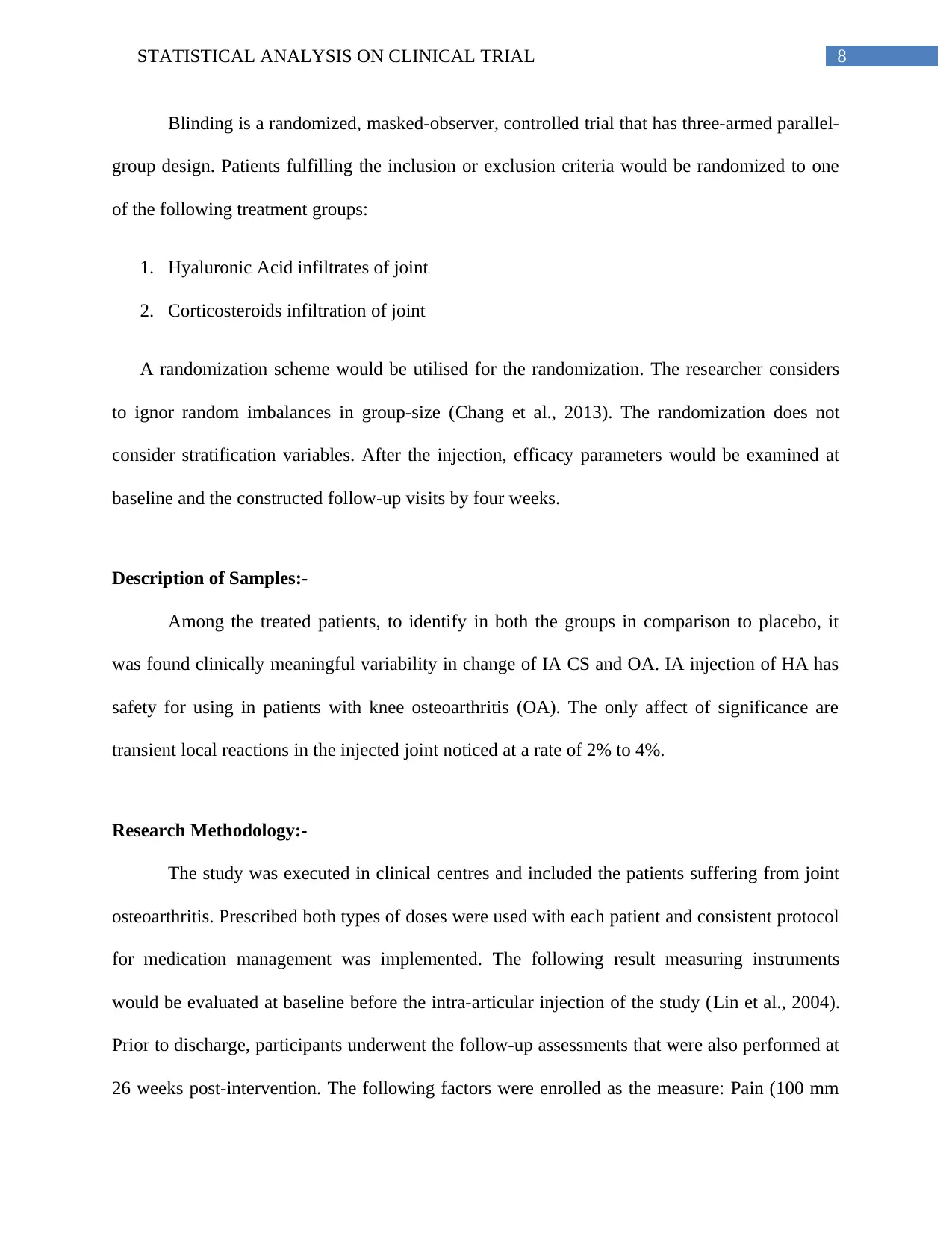
8STATISTICAL ANALYSIS ON CLINICAL TRIAL
Blinding is a randomized, masked-observer, controlled trial that has three-armed parallel-
group design. Patients fulfilling the inclusion or exclusion criteria would be randomized to one
of the following treatment groups:
1. Hyaluronic Acid infiltrates of joint
2. Corticosteroids infiltration of joint
A randomization scheme would be utilised for the randomization. The researcher considers
to ignor random imbalances in group-size (Chang et al., 2013). The randomization does not
consider stratification variables. After the injection, efficacy parameters would be examined at
baseline and the constructed follow-up visits by four weeks.
Description of Samples:-
Among the treated patients, to identify in both the groups in comparison to placebo, it
was found clinically meaningful variability in change of IA CS and OA. IA injection of HA has
safety for using in patients with knee osteoarthritis (OA). The only affect of significance are
transient local reactions in the injected joint noticed at a rate of 2% to 4%.
Research Methodology:-
The study was executed in clinical centres and included the patients suffering from joint
osteoarthritis. Prescribed both types of doses were used with each patient and consistent protocol
for medication management was implemented. The following result measuring instruments
would be evaluated at baseline before the intra-articular injection of the study (Lin et al., 2004).
Prior to discharge, participants underwent the follow-up assessments that were also performed at
26 weeks post-intervention. The following factors were enrolled as the measure: Pain (100 mm
Blinding is a randomized, masked-observer, controlled trial that has three-armed parallel-
group design. Patients fulfilling the inclusion or exclusion criteria would be randomized to one
of the following treatment groups:
1. Hyaluronic Acid infiltrates of joint
2. Corticosteroids infiltration of joint
A randomization scheme would be utilised for the randomization. The researcher considers
to ignor random imbalances in group-size (Chang et al., 2013). The randomization does not
consider stratification variables. After the injection, efficacy parameters would be examined at
baseline and the constructed follow-up visits by four weeks.
Description of Samples:-
Among the treated patients, to identify in both the groups in comparison to placebo, it
was found clinically meaningful variability in change of IA CS and OA. IA injection of HA has
safety for using in patients with knee osteoarthritis (OA). The only affect of significance are
transient local reactions in the injected joint noticed at a rate of 2% to 4%.
Research Methodology:-
The study was executed in clinical centres and included the patients suffering from joint
osteoarthritis. Prescribed both types of doses were used with each patient and consistent protocol
for medication management was implemented. The following result measuring instruments
would be evaluated at baseline before the intra-articular injection of the study (Lin et al., 2004).
Prior to discharge, participants underwent the follow-up assessments that were also performed at
26 weeks post-intervention. The following factors were enrolled as the measure: Pain (100 mm
⊘ This is a preview!⊘
Do you want full access?
Subscribe today to unlock all pages.

Trusted by 1+ million students worldwide
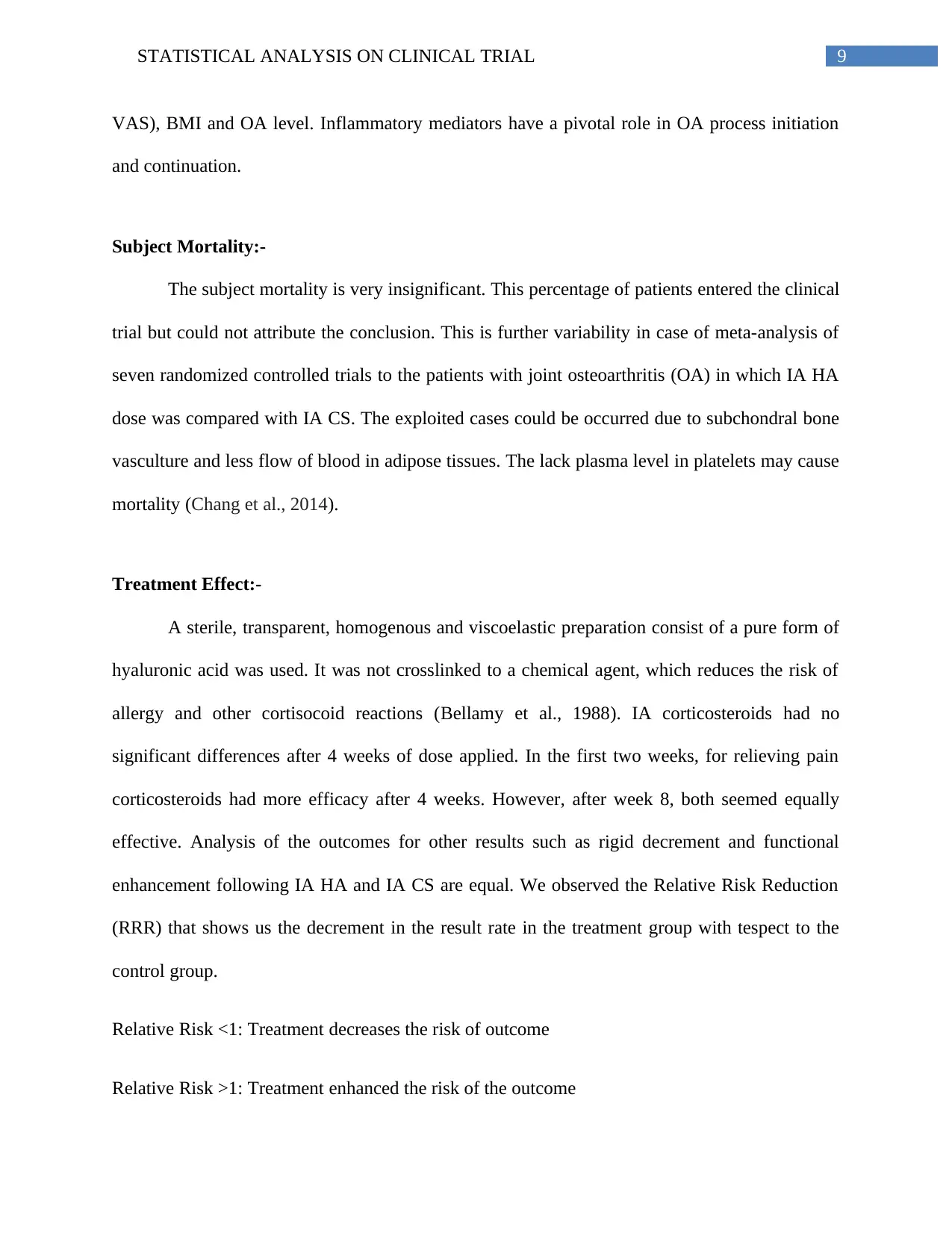
9STATISTICAL ANALYSIS ON CLINICAL TRIAL
VAS), BMI and OA level. Inflammatory mediators have a pivotal role in OA process initiation
and continuation.
Subject Mortality:-
The subject mortality is very insignificant. This percentage of patients entered the clinical
trial but could not attribute the conclusion. This is further variability in case of meta-analysis of
seven randomized controlled trials to the patients with joint osteoarthritis (OA) in which IA HA
dose was compared with IA CS. The exploited cases could be occurred due to subchondral bone
vasculture and less flow of blood in adipose tissues. The lack plasma level in platelets may cause
mortality (Chang et al., 2014).
Treatment Effect:-
A sterile, transparent, homogenous and viscoelastic preparation consist of a pure form of
hyaluronic acid was used. It was not crosslinked to a chemical agent, which reduces the risk of
allergy and other cortisocoid reactions (Bellamy et al., 1988). IA corticosteroids had no
significant differences after 4 weeks of dose applied. In the first two weeks, for relieving pain
corticosteroids had more efficacy after 4 weeks. However, after week 8, both seemed equally
effective. Analysis of the outcomes for other results such as rigid decrement and functional
enhancement following IA HA and IA CS are equal. We observed the Relative Risk Reduction
(RRR) that shows us the decrement in the result rate in the treatment group with tespect to the
control group.
Relative Risk <1: Treatment decreases the risk of outcome
Relative Risk >1: Treatment enhanced the risk of the outcome
VAS), BMI and OA level. Inflammatory mediators have a pivotal role in OA process initiation
and continuation.
Subject Mortality:-
The subject mortality is very insignificant. This percentage of patients entered the clinical
trial but could not attribute the conclusion. This is further variability in case of meta-analysis of
seven randomized controlled trials to the patients with joint osteoarthritis (OA) in which IA HA
dose was compared with IA CS. The exploited cases could be occurred due to subchondral bone
vasculture and less flow of blood in adipose tissues. The lack plasma level in platelets may cause
mortality (Chang et al., 2014).
Treatment Effect:-
A sterile, transparent, homogenous and viscoelastic preparation consist of a pure form of
hyaluronic acid was used. It was not crosslinked to a chemical agent, which reduces the risk of
allergy and other cortisocoid reactions (Bellamy et al., 1988). IA corticosteroids had no
significant differences after 4 weeks of dose applied. In the first two weeks, for relieving pain
corticosteroids had more efficacy after 4 weeks. However, after week 8, both seemed equally
effective. Analysis of the outcomes for other results such as rigid decrement and functional
enhancement following IA HA and IA CS are equal. We observed the Relative Risk Reduction
(RRR) that shows us the decrement in the result rate in the treatment group with tespect to the
control group.
Relative Risk <1: Treatment decreases the risk of outcome
Relative Risk >1: Treatment enhanced the risk of the outcome
Paraphrase This Document
Need a fresh take? Get an instant paraphrase of this document with our AI Paraphraser

10STATISTICAL ANALYSIS ON CLINICAL TRIAL
Relative Risk =1: No effect.
Power or Effect Size of the study adequate:-
Patients were divided into those who have acute and chronic inflammatory situations,
prevailing joint pain for at least 24 weeks. BMI and OA index were used determined. A single
high molecular weight hyaluronic acid dosage was found to be safe. It was found to be effective
to control pain in patients suffering from joint arthritis.
Statistical methods used for data analysis:-
Categorical variables (ex: age) were evaluated by t-test or chi-square, and continuous
variables (e.g., BMI, OA, burden of illness, quality of life, pain of arthritis) were measured
through means and standard deviations and t-tests. Analysis was performed using the SAS
software package.
Study results:-
This randomized and controlled study would give robust information on intra-articular
(IA) treatments applied in osteoarthritis compared to cortisocoid. PRP for patients who are
younger than 60 years, along with light OA and BMI (body mass index) less than 30 do not have
vividly mal-alignment. In case of the patients are older than 60 years along with BMI less than
30 and moderate OA, would apply PRP in injection that is preceded by a supplementary single
dose of HA injection after two to four years.
Relative Risk =1: No effect.
Power or Effect Size of the study adequate:-
Patients were divided into those who have acute and chronic inflammatory situations,
prevailing joint pain for at least 24 weeks. BMI and OA index were used determined. A single
high molecular weight hyaluronic acid dosage was found to be safe. It was found to be effective
to control pain in patients suffering from joint arthritis.
Statistical methods used for data analysis:-
Categorical variables (ex: age) were evaluated by t-test or chi-square, and continuous
variables (e.g., BMI, OA, burden of illness, quality of life, pain of arthritis) were measured
through means and standard deviations and t-tests. Analysis was performed using the SAS
software package.
Study results:-
This randomized and controlled study would give robust information on intra-articular
(IA) treatments applied in osteoarthritis compared to cortisocoid. PRP for patients who are
younger than 60 years, along with light OA and BMI (body mass index) less than 30 do not have
vividly mal-alignment. In case of the patients are older than 60 years along with BMI less than
30 and moderate OA, would apply PRP in injection that is preceded by a supplementary single
dose of HA injection after two to four years.
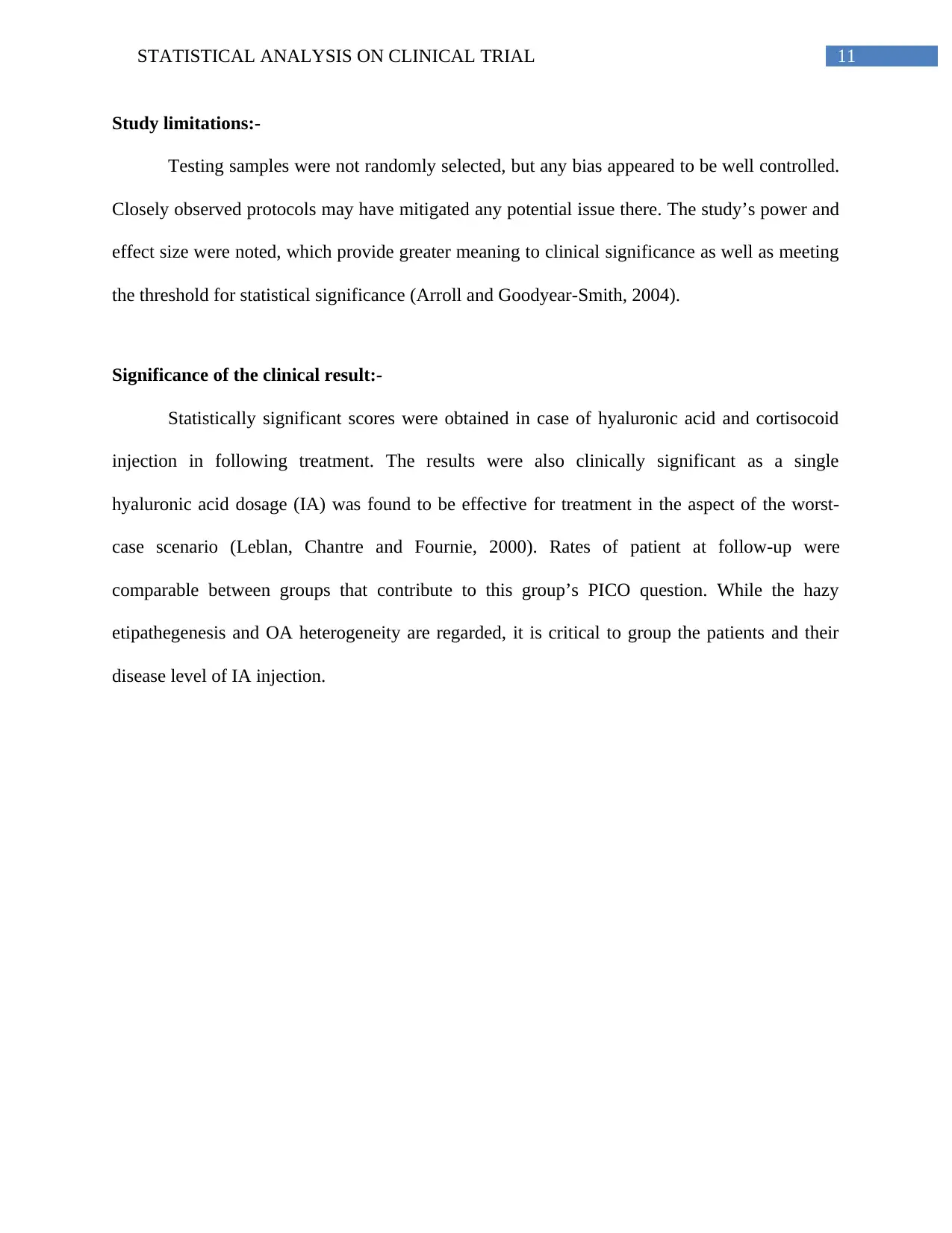
11STATISTICAL ANALYSIS ON CLINICAL TRIAL
Study limitations:-
Testing samples were not randomly selected, but any bias appeared to be well controlled.
Closely observed protocols may have mitigated any potential issue there. The study’s power and
effect size were noted, which provide greater meaning to clinical significance as well as meeting
the threshold for statistical significance (Arroll and Goodyear-Smith, 2004).
Significance of the clinical result:-
Statistically significant scores were obtained in case of hyaluronic acid and cortisocoid
injection in following treatment. The results were also clinically significant as a single
hyaluronic acid dosage (IA) was found to be effective for treatment in the aspect of the worst-
case scenario (Leblan, Chantre and Fournie, 2000). Rates of patient at follow-up were
comparable between groups that contribute to this group’s PICO question. While the hazy
etipathegenesis and OA heterogeneity are regarded, it is critical to group the patients and their
disease level of IA injection.
Study limitations:-
Testing samples were not randomly selected, but any bias appeared to be well controlled.
Closely observed protocols may have mitigated any potential issue there. The study’s power and
effect size were noted, which provide greater meaning to clinical significance as well as meeting
the threshold for statistical significance (Arroll and Goodyear-Smith, 2004).
Significance of the clinical result:-
Statistically significant scores were obtained in case of hyaluronic acid and cortisocoid
injection in following treatment. The results were also clinically significant as a single
hyaluronic acid dosage (IA) was found to be effective for treatment in the aspect of the worst-
case scenario (Leblan, Chantre and Fournie, 2000). Rates of patient at follow-up were
comparable between groups that contribute to this group’s PICO question. While the hazy
etipathegenesis and OA heterogeneity are regarded, it is critical to group the patients and their
disease level of IA injection.
⊘ This is a preview!⊘
Do you want full access?
Subscribe today to unlock all pages.

Trusted by 1+ million students worldwide
1 out of 14
Related Documents
Your All-in-One AI-Powered Toolkit for Academic Success.
+13062052269
info@desklib.com
Available 24*7 on WhatsApp / Email
![[object Object]](/_next/static/media/star-bottom.7253800d.svg)
Unlock your academic potential
Copyright © 2020–2025 A2Z Services. All Rights Reserved. Developed and managed by ZUCOL.




